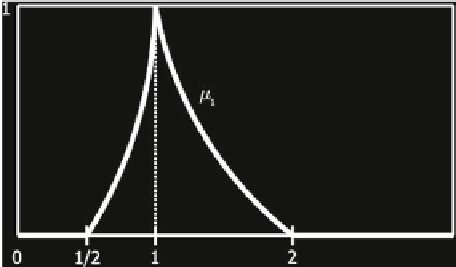Information Technology Reference
In-Depth Information
μ
m
, with
1
μ
m
x
,
if
x
=
0
1
or
μ
n
÷
μ
m
=
μ
n
(
x
)
=
0
,
and
μ
m
0
,
if
x
=
1
μ
m
m
=
1.
Let's compute the example
μ
3
÷
μ
3
, with
μ
3
as in Sect.
6.2.2
. It will be:
∈
4
,
3
⊧
⊨
1
1
4
−
y
,
if
y
3
∈
3
,
2
1
μ
1
1
(
y
)
=
y
−
2
,
if
y
⊩
,
.
0
otherwise
1
μ
Hence, for
μ
3
÷
μ
3
=
μ
3
3
, it will be
(μ
3
÷
μ
3
)(
1
)
=
1, and
1
y
=
ʱ
+
2
4
4
t
−
2
•
L
,
ʱ
=
4
−
=
x
−
2
⃒
t
=
x
·
y
−
ʱ
⃒
ʱ
=
t
+
1
1
4
−
ʱ
ʱ
+
4
−
2
t
•
R
,
ʱ
=
4
−
x
=
y
−
2
⃒
t
=
x
·
y
=
⃒
ʱ
=
1
.
2
t
+
That is
⊧
⊨
⊫
⊬
4
t
−
2
1
t
+
1
,
if
t
∈[
2
,
1
]
4
−
2
t
(μ
3
÷
μ
3
)(
)
=
=
μ
1
(
)
t
1
,
if
t
∈[
1
,
2
]
t
⊩
t
+
⊭
0
,
otherwise
Graphically,
Remark 6.2.3
Obviously, like in the product's case, the result is not a linear-
triangular fuzzy number, and the basic interval
[
a
,
b
]
is not symmetrical respect
n
to the point
m
.
6.2.3 Note
]
R
, and
As it is easy to see, if
μ, ˃
∈[
0
,
1
∗∈{+
,
−
,
·
,
:}
, it follows the relation
ʱ
between the corresponding
-cuts:










Search WWH ::

Custom Search